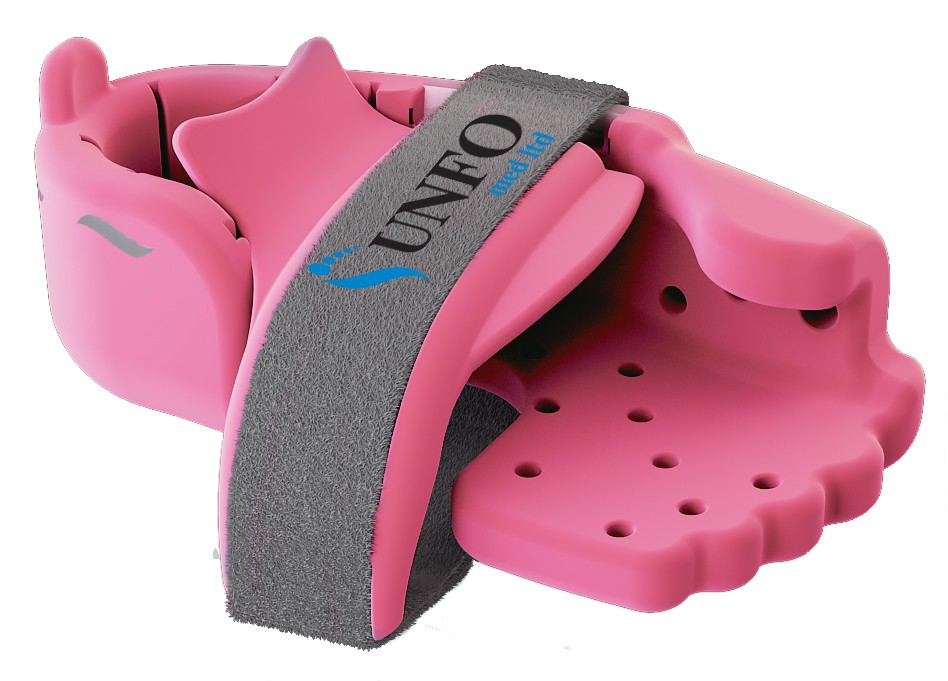UNFO
A revolutionary treatment for infants with Metatarsus Adductus
|
The Universal Neonatal Foot Orthosis (UNFO) is a revolutionary, child-friendly corrective foot brace that provides effective, safe, and stress-free treatment for Metatarsus Adductus (MTA) (also known as Metatarsus Varus and Forefoot Adduction) in newborns. UNFO addresses the difficulties and stresses of traditional treatment methods such as serial casting by providing a less invasive, safer method for treating MTA.
|
|
 |
 |
Before & After
UNFO offers a safe, comfortable, stress-free option – providing families with peace of mind and improving their quality of life.
| Before | During | After | ||
|---|---|---|---|---|
 |
 |
 |
||
Congenital Foot Deformity: Metatarsus Adductus
Congenital Foot Deformity: Metatarsus Adductus |
What is itThe Bleck classification system is the generally accepted method of assessing the severity of metatarsus adductus. MTA is divided into three grades of severity, depending on the relation of the heel bisector line and the toes. Further classification is based on manual flexibility. Bleck classification system:
Manual flexibility:
|
DiagnosisMetatarsus Adductus (MTA) is a congenital foot deformity prevalent among newly born babies. Untreated, it can lead to permanent physical deformity and long-term complications including aesthetic problems, difficulty wearing shoes, degenerative joint changes and chronic pain. MTA occurs in approximately 7% of births. When one sibling has a deformity, the incidence increases to 12%. Metatarsus adductus deformity causes the front half of the foot to turn inward, causing a C-shaped foot with a curved outer border. This is due to an off-centre deviation at the tarsometatarsal joints of the midfoot (the cuneiform bones rotate medially and the metatarsal bones deviate medially), causing the forefoot to adduct and supinate while the heel or hindfoot remains in a neutral or in slightly valgus position. While the cause of this condition is unknown, the foetus’ position in utero and family history are known to be contributing factors. |
|
MTA SeverityMILD – 20% – non self corrected MODERATE – 60% – non self corrected SEVERE – 100% – non self corrected |
|
Treatment OptionsThe goal of treatment is to straighten the forefoot and heel of the infant as early as possible. Traditional treatment methods include stretching exercises, strapping, serial casting and orthoses. Surgery is generally reserved for those cases unresponsive to conservative treatments. There are several clinical factors to consider when determining if treatment should begin and includes such factors as the natural history of the deformity including the likelihood of it persisting without treatment. |

Features of the UNFO
Components of the UNFO foot brace include: |
||
A rigid plastic insert to support the foot.The insert is covered by a soft thermoplastic material to prevent pressure area. |
 |
The strap has two major functions:
|
A circular adjustable strap that immobilizes the foot in the brace.Fixed over the medial wall of the brace, the Velcro strap (which features a wide and soft cushion for comfort) can be adjusted by the treating physician as the treatment progresses. |
|
|
|
The UNFO brace is available in two sizes and two colours and can be ordered as a pair, or individually for the left or right foot. The UNFO brace is generally suitable for infants up to 10 months of age.
|
 |
Clinical Research
Parents can be assured by the proven success of UNFO therapy in clinical trials published in leading medical journals. |
||

Universal neonatal foot orthotics—a novel treatment of infantile metatarsus adductus |

Novel device for nonsurgical correction of rigid forefoot adduction in children |

Metatarsus varus adductus (MTA): effectiveness of treatment with UNFO braces |
Why Choose UNFO Therapy |
|
Ready to order or need further assistance?
If your infant has a diagnosis of MTA and advice from your treating health professional to order the UNFO brace, please download the order form to return completed via email.
If you are seeking consultation or have been given a diagnosis and need further assistance, we are here to help. Simply eMail us and someone from our team will reach out. Thank-you!
